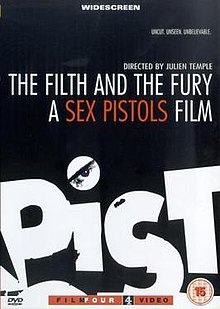The Filth and the Fury
This article has multiple issues. Please help improve it or discuss these issues on the talk page. (Learn how and when to remove these messages)
|
| The Filth and the Fury | |
|---|---|
 British DVD cover | |
| Directed by | Julien Temple |
| Written by | Julien Temple |
| Produced by | Anita Camarata Amanda Temple |
| Starring | |
| Cinematography | Julien Temple |
| Edited by | Niven Howie |
| Music by | Sex Pistols |
Production companies | |
| Distributed by | FilmFour Distributors |
Release dates |
|
Running time | 108 minutes |
| Country | United Kingdom |
| Language | English |
The Filth and the Fury is a 2000 British rockumentary film directed by Julien Temple.[1] It follows the story of punk rock pioneers the Sex Pistols from their humble beginnings in London's Shepherd's Bush to their fall at the Winterland Ballroom in San Francisco. It is considered a continuation of Temple's first documentary centered on the band, titled The Great Rock and Roll Swindle, but acts as an opportunity for the surviving members of the group to tell their side of the story.
Description
[edit]The Filth and the Fury is the second movie Julien Temple made about The Sex Pistols. His first movie was The Great Rock and Roll Swindle,[1] which was released in British cinemas on 15 May 1980.[citation needed] This earlier movie was criticised for being too skewed towards the Pistols' manager Malcolm McLaren's version of events about the band.[1][a] The Filth and the Fury tells the story from the viewpoint of the band members themselves (albeit in silhouette during their contemporary interviews).[1]
The title of the film is a reference to a headline that appeared in the British tabloid newspaper The Daily Mirror on 2 December 1976 after an interview on ITV's Today presented by Bill Grundy.[3] The title of The Daily Mirror article was itself inspired by William Faulkner's novel The Sound and the Fury which was in turn taken from a line in Shakespeare's Macbeth.
Temple's documentary narrates the rise, decline and fall of the Sex Pistols from their humble beginnings in London's Shepherd's Bush to their disintegration at the Winterland Ballroom in San Francisco.[citation needed] Temple puts the band into historical context with Britain's social situation in the 1970s through archival footage from the period. This film was promoted as an opportunity for the Pistols to tell their perspective of the story mostly through interviews with the surviving members of the group, footage shot during the era, and outtakes from The Great Rock and Roll Swindle.[3]
Soundtrack
[edit]The soundtrack to the film was released in 2002. The two-disc set contains songs by the Sex Pistols as well as music from other artists that was used in the film.
- Disc one
- "God Save the Queen (Symphony)"
- "Shang-a-Lang" – Bay City Rollers
- "Pictures of Lily" – The Who
- "Virginia Plain" – Roxy Music
- "School's Out" – Alice Cooper
- "Skinhead Moonstomp" – Symarip
- "Glass of Champagne" – Sailor
- "Through My Eyes" – The Creation
- "The Jean Genie" – David Bowie
- "I'm Eighteen" – Alice Cooper
- "Submission"
- "Don't Gimme No Lip Child"
- "What'cha Gonna Do About It"
- "Road Runner"
- "Substitute"
- "Seventeen"
- Disc two
- "Anarchy in the UK"
- "Pretty Vacant"
- "Did You No Wrong"
- "Liar"
- "EMI"
- "No Feelings"
- "I Wanna Be Me"
- "Way Over (In Dub)" – Tapper Zukie
- "Looking for a Kiss" – New York Dolls
- "Holidays in the Sun"
- "No Fun"
Notes
[edit]- ^ So Peter Bradshaw in The Guardian called the earlier movie "a gloating partisan account of the Sex Pistols from the point of view of their hated manager";[1] critic Roger Ebert, who had worked with McLaren and the band, called it "a version of the Pistols story supplied by Malcolm McLaren, their infamously self-promoting manager".[2]
References
[edit]- ^ a b c d e Bradshaw, Peter (12 May 2000). "Review: The Filth and the Fury". The Guardian. Retrieved 8 February 2024.
- ^ Ebert, Roger (7 April 2000). "The Filth and the Fury". Chicago Sun-Times. Retrieved 8 February 2024 – via RogerEbert.com.
- ^ a b Sinker, Mark (June 2000). "The Filth and the Fury". Sight and Sound. Retrieved 8 February 2024.
